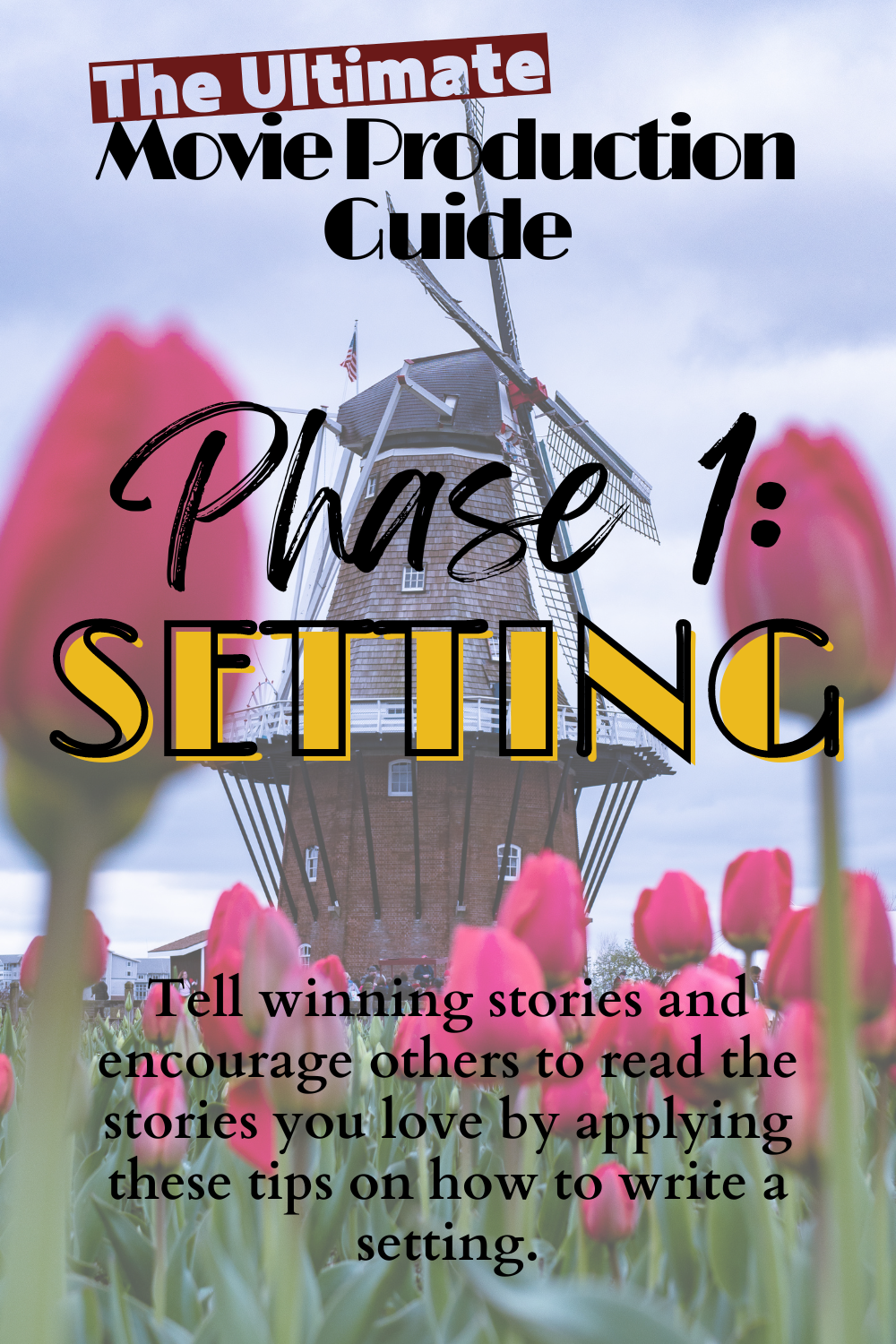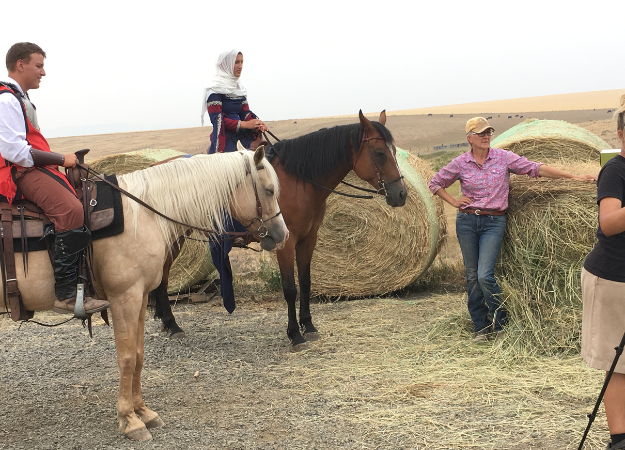- Home
- Movie Making Course
- How to Write a Setting
How To Write A Setting By Focusing On Circumstance

Welcome to Phase 1 of the Movie Production Guide!
Circumstance is the element of setting that is most often overlooked when both writing and evaluating stories. This lesson will teach you what a setting is and how to write a setting. Before we are done with this phase, you will:
So, let's get started!
How To Write A Setting
There are four literary elements to consider when writing a story of any kind, movie plots included. These are plot, setting, characters and theme. This phase focuses on setting.
Simply put, the setting is the place, time, and the circumstances that surround the plot and characters, and contributes to the overall theme.
Don't make the mistake of simply placing characters in a time and place. Rather engage in good storytelling by creating circumstances that influence your characters. This is key to writing a believable setting.
Task 1: Before You Learn How To Write A Setting It Is Helpful To Learn How To Evaluate A Setting

Evaluating stories or movies is the best way to learn how to write a setting that works.
A great setting is important in script writing.
It is crucial that you understand what a setting is if you want to be able to create stories that sell, ones that will become people's favorite movies that they will want watch again and again.
Think about when a friend has told you to watch or read a certain story.
What do they tell you about? Most likely, they give you a brief description of where and when the story takes place, who the main characters are and what challenge or goal the characters are trying to overcome or achieve.
Whether you realize it or not, people tell you the most compelling elements of the story's plot, setting, theme and characters without telling too much. That's what makes it so that you are still intrigued and want to watch the movie yourself.
How can you study this concept to improve your own storytelling? Simple. Just read books and watch movies that you know people love.
Classics are the best to analyze.
These stories have been read by audiences over a long span of time and are obviously winners to keep people engaged decade after decade. Studying what is popular now won't do you much good because who knows how popular they will be in 10, 20...50 years?
And you want your movies to be timeless, don't you?
Great suggestions that we can offer are:
- The Sound of Music
- Ben-Hur
- The Ten Commandments.
Now think about it...
Can you immediately tell me where these stories take place?
What time period they are placed?
What the main circumstances that force the characters to act to fix a problem?
Most people can and that proves that those stories have good settings. You want your audience to be able to tell their friends about your movies just as easily.
Task 1 Checklist: (Print Worksheet)
Before you go any further watch your favorite movie, and analyze the setting. When you are done watching it, fill out this Task #1 checklist:
1. Where does the story take place?
2. When does the story take place?
3. Who are the main characters? Include character strengths, flaws and quirks if they are important to the plot of the story.
4. What is the main problem that the characters are working to fix?
5. Is there an antagonist or are the characters all good, just battling each other over misunderstandings?
Now that you are able to identify and analyze a setting, it's time to write your own.
Task 2: Write Your Own Setting Using The Elements You Have Learned
Here's An Example Of How To Write A Setting From Our Favorite Charlotte M. Yonge Novel
Take a look at the story Grisly Grisell by Charlotte Yonge. The obvious place of the story is in England and Holland. It takes place in castles, convents, taverns, and courtyards. These all tell the "where" of the story. The era is the fifteenth century.
This is all important to the setting, but a major part of this important literary element has yet to be developed.
The cleverness of Yonge's work is the way she tells the story of the Wars of the Roses through the unlikely romance between Leonard Copeland and Grisell Dacre.
The circumstances the plot unfolds is what makes the story so wonderfully endearing.
The story's setting has for a backdrop the turbulent years of the English Civil War. The royal family at the time was King Henry VI who went mad and his French queen Margaret of Anjou.
The controversy that sparked the war was differing opinions on who should rule (seeing as the king was unfit) the French queen or the Duke of York?
The queen's army bore a red rose and the duke's wore a white rose thus giving the war the name the "Wars of the Roses".
Ultimately the red rose lost and the duke's line became the new heirs to the British throne.
These are the political events and circumstances surrounding the main characters.
Grisell Dacre and Leonard Copeland are on opposing sides of the war and they are entered into a marriage contract to help heal the feud between the two families.
Grisell's family is on the side of the White Rose and is loyal to the duke and Leonard Copeland's family is loyal to the Red Rose that supports the queen.
Every event that occurs as the romance unfolds is a consequence of the Wars of the Roses.
Their being raised in the same household, the marriage contract being broken, his being captured and forced to marry Grisell, his being forced to take the tower and keep Grisell as his wife despite being in love with another, all these are events that make up the setting of the story.
And the final climatic events lead to a happy and satisfying ending that readers and audiences love!
Start Writing Winning Story Settings That Will Give Your Movies A Believable Lift

All of these elements pertain to movie making because the scriptwriter and the director need to deliver a great story setting visually which in some ways can be more difficult but does not need to be if a lot of attention to detail is discussed in the preproduction stage before a single word hits the script.
Which is why writing a setting is the first step to moviemaking.
Getting these tasks done now will save you from a lot of discouragement later down the road. While formulating a movie script you will not only need to consider a time and a place, but you must also think about what sort of experiences and personalities may have affected the character.
Time and place do matter. Every story must have them, even if you don't think it is important to mention them in the actual movie through the lines. The creative talent must at least have a picture of where you are and what era you are working in.
There must be places and some sense of the time.
When you are writing a setting, you want to make sure it is compelling and brings the story forward rather than bogging it down. A setting can be filling in a backstory or telling little known (but necessary to the storyline) facts about the place or time.
For the things that affect characters as individuals, you have another set of things to consider:
- Is the problem something that a whole group of people suffered, such as a civil war?
- Or is it more personal for your character, as in an accident that left your main character with a mar, emotional or physical?
- Is there a real physical problem (invasion, escape, multiple attacks from an enemy) or is the challenge a more abstract problem (a clash of personalities as common in a romance)?
When you start working with your actors in Phases 6 and 7, you are going to want them to immerse themselves in their character, but you need to do this now at this point of script development.
Immerse yourself in the time and place you are hoping to take people to in your film. Jump in your characters’ shoes (or, even better, their minds) and take a look about you. What do you see? How do you feel?
Start thinking about your characters. If your story is based on a true story, read every article, book, and history section that you can about your story. Research paintings of what the place looked like, what the people's clothing looked like, what the buildings looked like...you get it.
Put yourself in every character's situation and consider what that person did and what may have motivated him. Think about these four questions:
- Who is influencing your characters?
- Who is influencing their culture?
- What are their customs?
- What is happening in their country when the story takes place and how does it affect them?
Grow to love the story so much that all you can think about is how to make it happen in movie form and be as realistic as possible.
Keep a way to take notes handy. You never know when the mood or new ideas will strike you and it will be good to get those ideas down on paper so that you don't forget them when it's time to write.
Task 2 Checklist:
1. Research the time and place of your film.
2. Immerse yourself in the era and place.
3. Are there any interesting tidbits that could be useful to your story?
4. Think about each of the characters you are thinking of making as individuals. What influences and motivates them?
5. What is happening during the era of your film? It doesn't matter if it is in the same country that your movie takes place, just make sure you know about everything that the characters might be talking and thinking about (Like the reference to Isaac Newton in The Siege of Vienna).
6. Take lots of notes!
That does it for this phase. Now that you have your setting firmly set in your mind (and ideally written down on paper), you are ready to move on to Phase 2, Screenwriting Tips and Techniques.
Are You Not Feeling "Set" To Go Yet?
Did I miss something on this page? Do you have any more questions about your setting, the setting for our current film, settings in general? Please leave it below. I'd be happy to help you with them!

